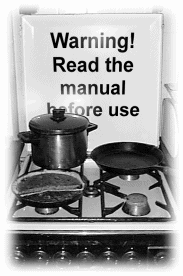Issue
Article
Vol.30 No.2, April 1998
Article
Issue
Issue |
Article |
Vol.30 No.2, April 1998 |
Article |
Issue |

One of my best friends almost succeeded in blowing me up last time she visited from Britain.
It was accidental of course and it is directly connected to user interface design. It all has to do with the knobs for controlling the gas burners on our cooker. In Britain turning the knob anti-clockwise takes the burner from the off-state to on-low (simmering) and turning it further increases the gas, making the flames hotter, until at the end the burner is on full. This is a similar situation to on/off volume controls on radios; you turn the dial taking it from off to on-low and through to on-high.
Contrast this to gas knobs in some other European countries (such as where I live) where the sequence is: off to on-full, and then down to on-low; the simmering state is right at the end of the range instead of at the beginning.
This has the advantage that you can quickly turn the knob into the simmer state while cooking, without the danger of it slipping into the off state if you go too far. The disadvantage is that due to the inconsistencies in the two systems, visitors from Britain trying to turn the gas off will often turn the knob from on-full to simmer and because the knob won't turn any further they then assume it is off. If it is lit it remains burning on simmer, but if for some reason it wasn't lit then it remains pumping a small stream of gas into the kitchen...
Last issue I discussed snooze functions; states that sit in-between two distinct states. Another important concept are states that lie in between two other states but they are all part of a range. The simplest example is the volume knob mentioned above.
Often with such systems there are irregularities introduced in the interaction to isolate key states in the range. The most obvious states are the beginning state and the end state. In some interactions these states are desirable for some reason and so are made difficult to leave. Consider again the gas knob; you usually have to push it in before you turn it on, the state at the beginning of the range (off) is isolated and thresholded from the rest of the range.
Other examples are car doors; when a door is fully closed it is useful to have it remain in this state while travelling, thus doors have catches to make getting out of this state a thresholded action (pretty common sense actually).
Key states in such ranges are not just thresholded in this way, sometimes the system has a built in tendency to return to the state; doors that tend to close themselves, joysticks that automatically re-centre themselves, etc.
The interesting group is ranges where the key state is not at the end or beginning but is an interim state; somewhere in the middle. Consider car doors again: you are very often opening them in cramped situations, parked next to other cars, parked alongside a busy road. In those situations you may want the door open but not open all the way. many car doors support this by having an interim state built in, a point at which the door can be left half open and it stays half open.
Similar interim states can be found on some hi-fi controls. The balance knob usually has gives a little tactile `bump' when the balance is equal for the two channels. Some British cookers pick out the simmer state in the range in a similar way.
These interim states are built in, based upon objective ideas as to which states are important to the users. But very often with such ranges the important state is purely subjective and as such cannot be built in. With our electric toaster, the cooking time control has one state which is vital to me; the state for nicely done toast. However this is different to the equivalent state for my girlfriend, sometimes leading to explosions of a different kind in the kitchen!
The only thing that systems can offer to help here are presets: several independent controls for the range and a way of switching between them. Televisions supply you with up to a hundred presets; imagine zapping if you just had one dial like a radio. So, toaster manufacturers are you listening? We'd have a range control for me (that I could set to nicely done toast), and another one for Wendelynne (that she could set to warm, floppy, slightly-singed bread), oh, and a third one for whoever is visiting from Britain. That is if they hadn't already blown the kitchen up.
Lon Barfield
Lon Barfield is the author of `The User Interface, Concepts and Design' (Addison Wesley) and is an associate director of General Design (http://www.design.nl/). He can be contacted at lon@design.nl.
Issue |
Article |
Vol.30 No.2, April 1998 |
Article |
Issue |